Do you know, that 97 cybercrimes happen every hour? This means, there is at least one victim in every 37 seconds.
Both web and mobile applications are an integral part of any organization. New features and technology in these applications have given rise to a wide range of unique vulnerabilities. This is why you need to test your applications regularly.
Application security testing (AST) helps identify and eliminate vulnerabilities in software applications, including web apps and mobile apps. It started as a manual process, but with the evolution of technology, many automated tools have also emerged, simplifying the process. However, it is best to combine both manual and automated techniques to get accurate results.
If your company operates software applications, this blog is going to benefit you a lot.

What is Application Security Testing?
Application security testing (AST) is the process of making software applications more resistant against cyber threats, by detecting security vulnerabilities in the source code. Organizations employ cybersecurity professionals to test their applications to find weaknesses that hackers could exploit for unauthorized access.
It is now a major part of DevSecOps, as companies ensure their application is secure before it is sent to the market. Security testing enables the development teams to create more secure code and protect applications against various cyber threats.
The process involves testing, analyzing, and reporting on a software application’s security measures, as it progresses throughout the software development lifecycle (SDLC). The main goal of application security testing is to find security flaws that could lead to cyberattacks.
Want to look at a real application security testing report? Just click the button below and download one right now!
Latest Penetration Testing Report

Why is Application Security Testing Important?
Records show, that over 50% of data breaches happened through applications. Many of those breaches could have easily been prevented if they had proper security measures. And how to have proper security measures? Application security testing.
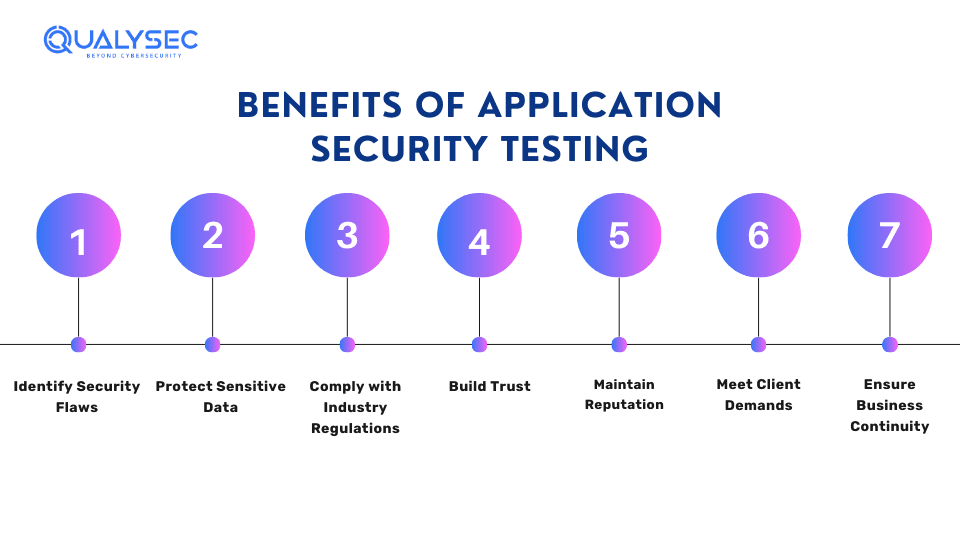
There are multiple benefits of application security testing:
1. Identify Security Flaws
Testing your application early in the development process helps identify security flaws before they become significant issues. Early detection allows for quick resolution, minimizing the time and resources required for fixes. This proactive approach saves both time and money in the long run, as addressing security flaws during development is often more cost-effective than fixing them after deployment.
2. Protect Sensitive Data
Securing sensitive data is crucial for maintaining user trust and compliance with regulatory requirements. Application security testing helps identify vulnerabilities that could compromise data confidentiality, integrity, and availability. By implementing robust security measures, organizations can prevent unauthorized access, data breaches, and financial losses.
3. Comply with Industry Regulations
Regulations such as PCI DSS, GDPR, ISO 27001, and others mandate specific security measures to protect sensitive data and ensure privacy. Application security testing helps organizations identify and address gaps in compliance. As a result, it helps reduce the risk of regulatory penalties, fines, and legal consequences.
4. Build Trust
Trust is the foundation of any successful business relationship. Users expect applications to be secure and reliable, especially when handling personal information and financial transactions. By prioritizing security and conducting regular testing, organizations can build trust with their users and stakeholders. When you show your commitment to security, it helps you stand out from your competitors and enhances your brand image.
5. Maintain Reputation
A security breach can have severe consequences for an organization’s reputation and brand image. While financial losses from a breach may be temporary, reputational damage can be long-lasting and difficult to repair. Application security testing helps prevent security breaches by identifying vulnerabilities and weaknesses before they can be exploited by hackers. By maintaining a strong security posture, organizations can protect their reputation among their customers and stakeholders.
6. Meet Client Demands
Clients want their sensitive data to be adequately protected when using your application. Meeting client demands for security testing demonstrates a commitment to customer satisfaction and builds trust in your products and services. By following client requests for security testing, organizations can strengthen relationships with them and enhance their competitive position in the market.
7. Ensure Business Continuity
Security incidents such as data breaches can disrupt operations, damage reputation, and result in financial losses. Application security testing helps mitigate potential security risks by identifying vulnerabilities and weaknesses that could impact the availability and reliability of the application. By proactively addressing security threats, organizations can ensure business continuity, protect revenue, and achieve a better return on investment (ROI) for their technology investments.
Different Types of Application Security
In the business world, 3 major types of software applications need proper security to prevent cyberattacks. These are:
-
- Web Applications
- Mobile Applications
- Cloud Applications
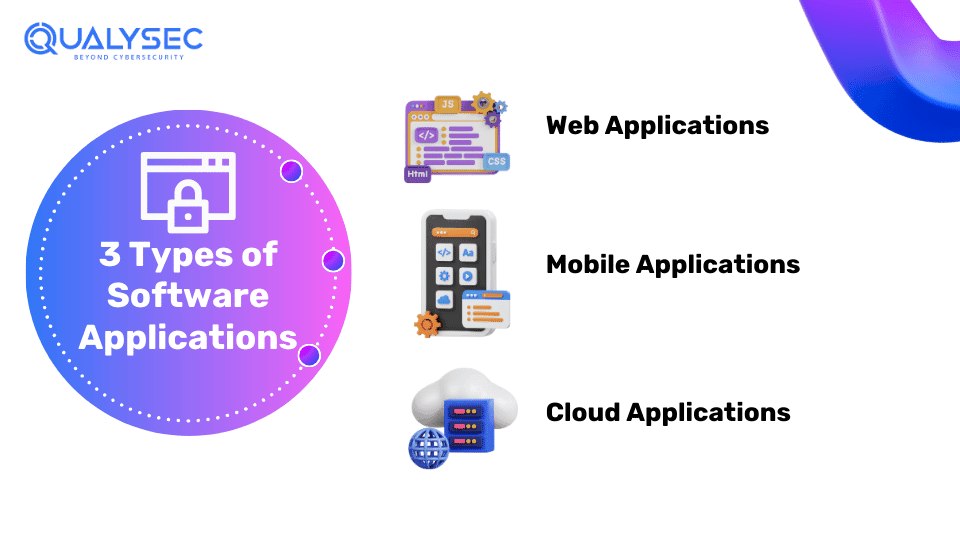
1. Web Application Security
Web application security is to implement the best security measures to keep them safe from cyberattacks. Just like any other software, web apps can have weaknesses that cybercriminals might exploit. To avoid design and implementation flaws, web application security involves using safe development practices during the software development life cycle (SDLC).
2. Mobile Application Security
Mobile application security focuses on the security posture of mobile apps on platforms like Android, iOS, and Windows. It covers apps that run both on smartphones and tablets. Since mobile apps are used by almost everyone nowadays and they store highly confidential data, it is important to have robust security measures. Methods like penetration testing can help uncover vulnerabilities that could cause data leaks in mobile apps.
3. Cloud Application Security
Cloud application security is a set of policies and controls that help organizations protect applications and data present in cloud environments. It includes identifying and managing access controls, infrastructure security, logging and monitoring, and configuration analysis. Additionally, it also includes vulnerability mitigation and data protection.
5 Types of Application Security Testing
Security teams have different types of application security testing tools and techniques. These have specific functions and most of them fall into one of the following categories.
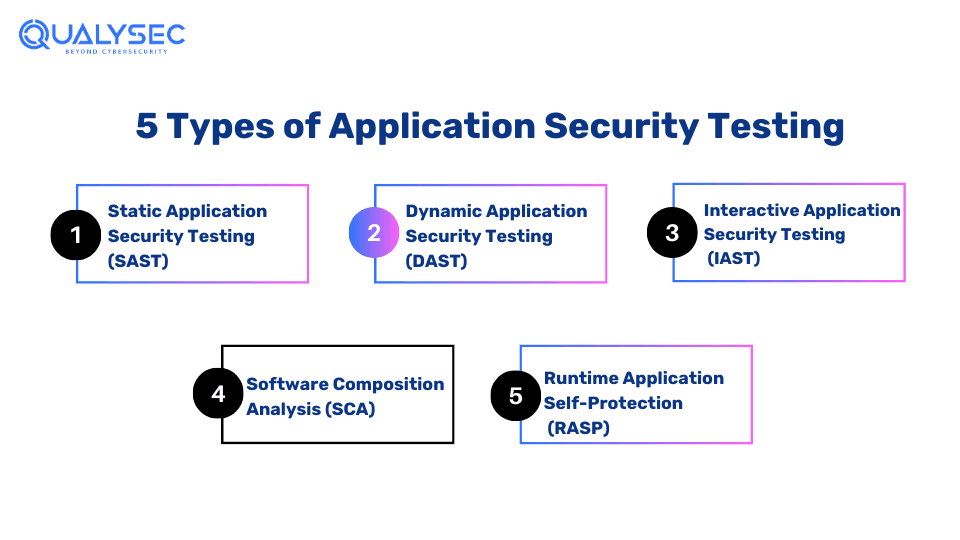
1. Static Application Security Testing (SAST)
SAST or source code analysis is a white box testing method that tests source code at rest. Here the testers have all the information about the application’s coding structure. It looks for any weak points that could be exploited by hackers. These tools can be applied to various forms of code, like applications, bytes, and binaries. Once your code is analyzed, it highlights design and coding flaws that can be exploited.
2. Dynamic Application Security Testing (DAST)
DAST is a type of black box testing, where the testers have no idea about the structure of the application. It simulates real cyberattacks on the running application to find architectural weaknesses and security vulnerabilities. This process is also known as penetration testing, where cybersecurity professionals or ethical hackers perform the application testing. Additionally, it is by far the best way to find security flaws in software applications.
3. Interactive Application Security Testing (IAST)
In IAST, testers scan the already-built source code of your application in a dynamic environment. It is usually executed in the QA environment and in real-time when the application is running. It helps find vulnerabilities in the coding structure and provides immediate remediation steps. You can easily implement the IAST method into your continuous integration/continuous delivery (CI/CD).
4. Software Composition Analysis (SCA)
SCA tools scan your application’s code to show you what open-source software it uses. The testers find all the open-source parts and the license compliance data of the components. Additionally, they identify any common security issues present in the code. Some SCA tools can even help you fix these issues by sorting them out and suggesting remediation methods.
5. Runtime Application Self-Protection (RASP)
RASP is a security technology that adds an extra layer of defense to applications. It protects and prevents cyberattacks in real-time. Unlike traditional security tools like firewalls or antivirus software, RASP keeps an eye on the application while it’s running.
Want to secure your software applications from various security risks?
Qualysec Technologies provides the best application security testing through hybrid penetration testing services. So, if you want to keep your application and business running smoothly, click below!
Talk to our Cybersecurity Expert to discuss your specific needs and how we can help your business.
Conclusion
In a digital world where cyberattacks are increasing every second, it is important to secure web, mobile, and cloud applications from evolving cyber threats. Application security testing can help you find vulnerabilities in your software applications and take the necessary steps to fix them early.
By implementing the necessary security measures, you can protect sensitive data, comply with industry regulations, build trust with users, and meet client demands. Additionally, investing in application security testing is not just a proactive measure; it’s a necessary step to secure your organization’s assets and maintain a competitive edge in the market.
FAQs
Q: What is app security testing?
A: App security testing is a testing approach that analyses the source code and other app architecture to identify vulnerabilities. It is done by cybersecurity professionals through various automated and manual techniques.
Q: How is application security testing done?
A: The process of application security testing involves an active analysis of the application for any weaknesses, technical flaws, or vulnerabilities. As a result, the vulnerabilities found are presented to the app owner, along with the severity of their impact, and remediation steps.
Q: Which security testing technique is best for testing applications?
A: DAST or Dynamic Application Security Testing, also known as penetration testing, is best for applications. It involves manually simulating real-world cyberattacks on the application to find where the security flaws lie.
Q: Why application security is important?
A: Application security is important to:
-
- Free the application from vulnerabilities
- Meet compliance needs
- Protect sensitive data
- Build customer trust
- Maintain reputation
- Ensure business continuity









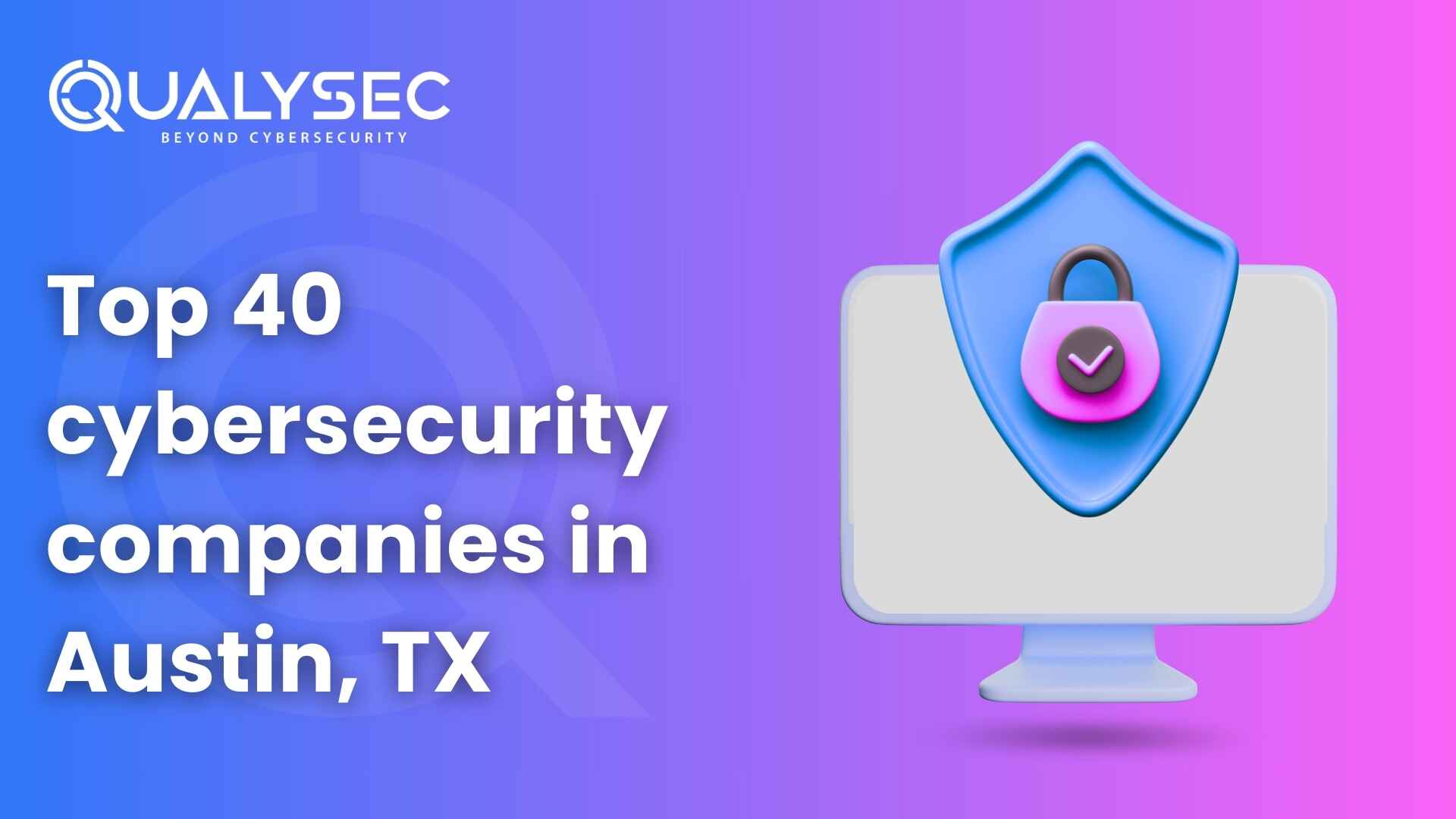



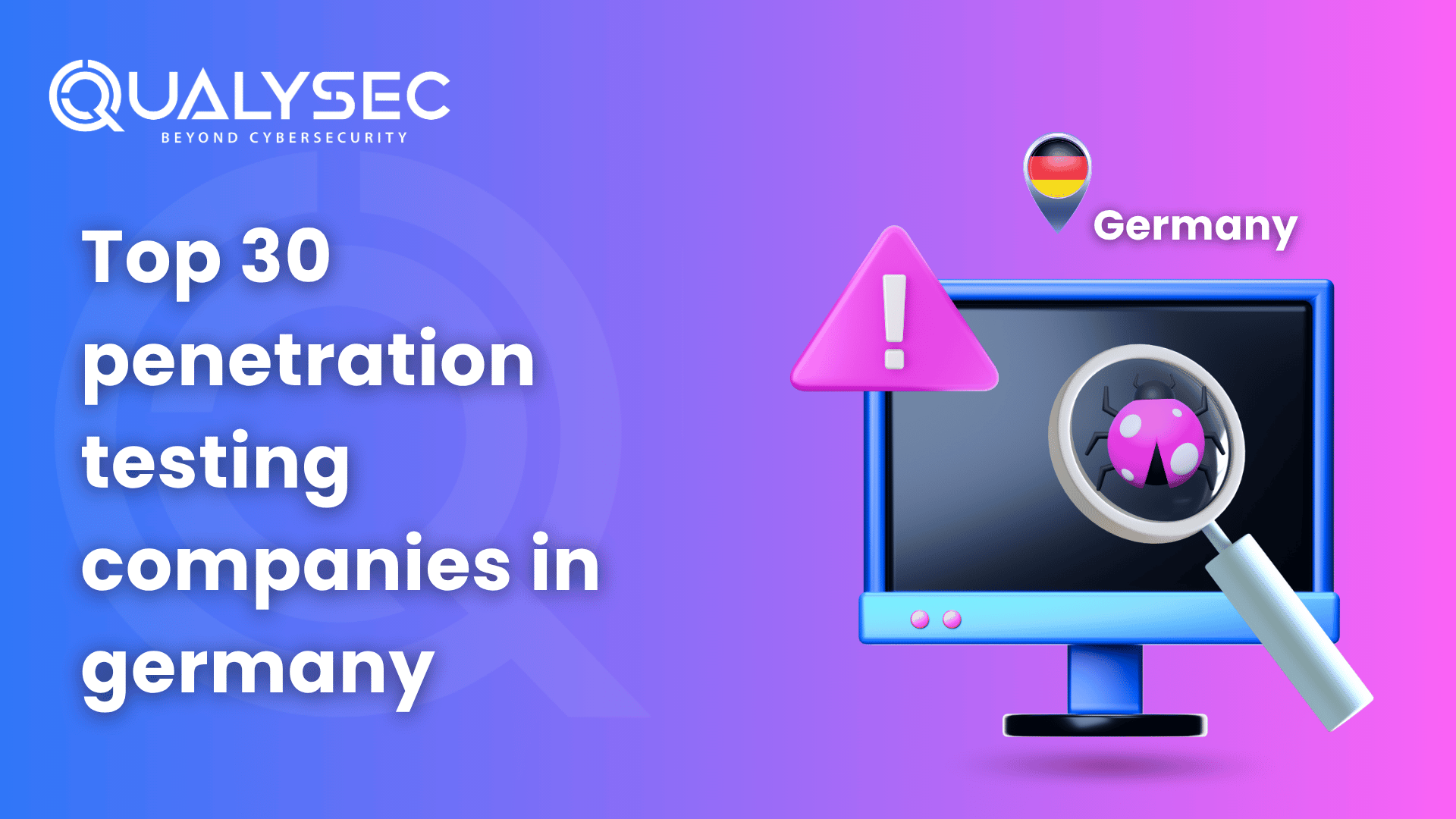























































































































































































































































































































































































































































































































0 Comments